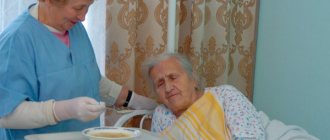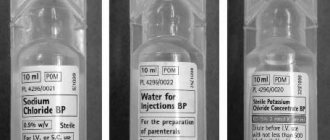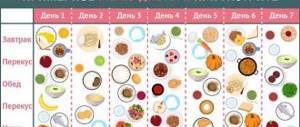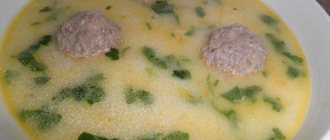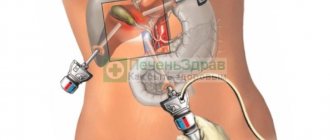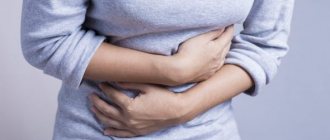Prerogative aspects of laparoscopy
Laparoscopy is mostly used for abdominal and gynecological surgeries. Less common in thoracic surgery (on the chest). The prerogative aspects of the operation are:
- shorter time interval for the operation;
- minimal tissue trauma (minimally invasive intervention);
- accelerated patient rehabilitation;
- the possibility of using laparoscopy as a diagnostic procedure;
- minimal risk of developing adhesions;
- aesthetic appearance of postoperative scars.
Despite the fact that laparoscopic surgery has a number of advantages over conventional abdominal surgery, as with any surgical intervention, many patients have abdominal pain after laparoscopy, as well as weakness, nausea, and decreased appetite. Short-term pain syndrome is not a pathology. If the pain persists for a long period of time, we can assume the presence of postoperative complications.
Preparation
Before any surgical operation, especially when the cancer process affects the stomach, a number of laboratory and instrumental examinations are mandatory.
Their necessity lies in determining the functionality of vital internal organs and systems, identifying the location of the malignant neoplasm and the extent of metastases. Patients are prescribed:
- clinical and biochemical blood test;
- general urine analysis;
- microscopic examination of stool for occult blood;
- chest x-ray;
- gastroscopy - an endoscopic procedure for examining the internal surface of the digestive organs;
- biopsy – to confirm the progress of cancer;
- Ultrasound of the abdominal organs;
- CT and MRI.
Medicinal preparation of the patient includes:
- taking medications to improve the functioning of the digestive system;
- the use of sedatives - to improve sleep and general well-being;
- transfusion of protein drugs and blood plasma, in cases of anemia;
- the use of medications to improve the functioning of the liver, cardiovascular system and kidneys;
- taking antibiotics;
- use of hemostatic agents;
- gastric lavage.
In addition, psychological preparation for surgery is very important. The doctor must explain to the patient the need for it, the advantages of carrying it out and the disadvantages of refusal.
Very often, preoperative preparation includes the use of chemotherapy, which will lead to a reduction in size or inhibition of the growth of a malignant tumor.
Adequate preparation ensures not only a positive result of surgical intervention, but also prevents the formation of complications after removal of the stomach.
Common causes of pain
Pain after laparoscopic surgery can have a varied nature, location and duration. This depends on the organ operated on, the complexity of the operation and the quality of its implementation.
Common reasons why a particular area of the body hurts are:
- Injury to the external integument, soft tissues and internal organs due to surgical incisions and the introduction of surgical instruments into the body. The localization of pain corresponds to the site of the operation.
- Painful sensations of a bursting nature caused by the introduction of carbon dioxide. This manipulation is performed to stretch the walls of the abdominal cavity so that the internal organs are better visualized. The pain is located not only in the operated area, but can radiate (give) to the chest area and shoulders.;
- Violation of the postoperative regimen by the patient. After laparoscopy, it is necessary to adhere to a dietary diet and limit physical activity. Failure to follow the rules leads to pain.
- Headaches, dizziness, discomfort in the throat. They arise as a result of anesthesia. Anesthesia in this case is carried out endotracheally, that is, simultaneously through the respiratory tract and intravenously. Painful phenomena are usually short-term in nature.
How intensely and how long the postoperative suture hurts depends on the individual characteristics of the patient’s body and the quality of the surgery performed.
Within twelve hours after surgery, pain is not abnormal.
causes of pain after surgery
Pain after surgery to remove a herniated disc has special manifestations: lower back pain may disappear, but appear after some time; The foot may begin to go numb, the pain in the leg may intensify, the entire leg may tingle and a feeling of “crawling goosebumps” may appear, and it is often painful to lean on the leg. Relative relief occurs only in bed in a certain position (on your side, lying on your stomach, etc.).
Pain after other types of operations is similar in its manifestations: pain and stiffness when moving, muscle spasms, aching pain in the suture area.
The reasons for the development of pain after surgery to remove a herniated intervertebral disc, both in the immediate and late postoperative periods, are:
- deep and superficial postoperative scars that compress painful nerve endings, blood vessels and nerve trunks;
- narrowing of the spinal canal from scars and stagnation of venous blood, compression of the spinal cord and nerves;
- progression of osteochondrosis, the appearance of new hernias in adjacent intervertebral discs;
- inflammation in the spinal canal of the spine;
- inflammation of the intervertebral joints (arthrosis);
- spasm of the muscles of the lower back and pelvis in the area of the surgical suture;
- incomplete removal of the hernia, which continues to put pressure on the nerve root;
- damage to nerve trunks, leading to numbness and dysfunction of the limb.
After other operations, pain occurs for the following reasons:
- deep and superficial postoperative scars that compress painful nerve endings, blood vessels and nerve trunks;
- muscle spasm in the area of the surgical suture;
- inflammatory process in the soft tissues around the surgical suture;
- disruption of metabolic processes in the soft tissues around the surgical suture;
- formation of adhesions between the suture and the membranes of internal organs;
- venous and lymphatic edema in the extremities.
Postoperative period without complications
Abdominal pain after laparoscopy is normal, as the body experiences stress from the violent intervention. With a normal outcome of the operation, the nature of the pain should look approximately as follows:
- continuous and intense in the area of the incisions - in the first twelve hours after laparoscopy;
- weak aching, radiating to the upper body - throughout the day;
- discomfort and mild pain – within 48 hours;
- acute short-term pain when making sudden movements - during hospital treatment.
After laparoscopic intervention, the patient remains in hospital for 3 to 6 days. By the end of your hospital stay, there should be no pain.
How long do they live after stomach removal for cancer?
Life without a stomach is a set of unique rules that must be followed daily. Especially if it was not partial, but complete resection. It is believed that the greatest likelihood of the disease developing again in the form of a relapse is the first 5 years after surgery. If during this time there is no re-formation of tumor bodies in neighboring organs, the esophagus or other parts of the digestive system, then in this case you can count on complete elimination of cancer.
Such a person can live to a ripe old age and die from completely different pathologies.
If it so happens that the removal of the stomach for cancer generally went well, the patient recovered quickly and there were no significant complications, but in the next 5-year period cancer cells were re-discovered in the blood, then the further life span in rare cases exceeds 10 years frontier Often, new oncological formations of malignant etiology are discovered in a person, which grow even faster than the previous tumor. In addition, the patient’s body becomes very weakened, since gaining weight after removal of the stomach is not an easy task, and most of the nutrients are simply not absorbed by the digestive system.
Pain relief
How long after laparoscopy can I play sports?
To eliminate pain, analgesics and non-steroids and drugs with anti-inflammatory effects are used in a hospital setting. These medications inhibit (block) the physiologically active compound prostaglandin, as a source of spread of the inflammatory process.
Analgesic medications are prescribed with caution, as they have a negative effect on the hematopoietic process in the body. When pain decreases, analgesics are discontinued so as not to cause unwanted side effects.
If the pain does not differ in intensity and duration (it is tolerable), doctors recommend abandoning painkillers. In severe cases, narcotic opium alkaloids (opiates) are used. In a situation where acute continuous pain haunts the patient for more than 12 hours, ultrasound or other hardware diagnostics are required to establish the cause and identify possible complications.
Adaptation of patients after gastrectomy
Rehabilitation and adaptation to new nutritional conditions lasts about a year. During this period, complications are possible:
- Reflux esophagitis. Inflammation of the esophageal mucosa caused by the reflux of intestinal contents and bile from the small intestine.
- Dumping syndrome. It occurs as a result of the entry of unprocessed food into the intestines and is accompanied by vegetative crises - dizziness, sweating, weakness, palpitations, sometimes after eating a single vomiting occurs.
- Anemic syndrome.
- Fast weight loss.
- Hypovitaminosis - most vitamins are absorbed in the stomach. In its absence, the necessary compounds are not absorbed. Correction: parenteral administration of multivitamin complexes.
These accompanying symptoms are noted by all patients, communicating on the forum and sharing their experiences of how they live after removal of the stomach.
Features of nutrition and diet
Diet therapy in the postoperative period is the main component of rehabilitation.
The main task of the diet:
- create peace for wound healing at the junction of the esophagus and duodenum;
- provide the body with basic nutritional ingredients;
- prevent intestinal bloating.
Immediately after surgery in a hospital setting, the patient is prescribed fasting on the first day. For nutrition, the parenteral method is used, that is, intravenous administration:
- saline solutions (Trisol, Disol);
- amino acids (Aminoplasmal);
- glucose;
- specialized mixtures (Kabiven).
If the postoperative period passes without complications, from the third day you can give a not very sweet compote or rosehip decoction in the amount of 250 ml per day. Drinks are often given by the teaspoon.
If the patient’s condition is satisfactory, they successively switch to surgical diets:
- on days 4-5, diet 0A is allowed;
- on days 6-8 - diet 0B;
- on days 9-11 - diet 0B.
When switching from one surgical diet to another, the caloric content of dishes is gradually increased and new foods are added. At first, everything should be served only liquid, then gradually move on to pureed and pureed dishes.
The duration of each table of the surgical diet usually lasts from 2 to 4 days, if necessary it can be adjusted.
In the future, the menu is supplemented with easily digestible products containing a sufficient amount of necessary components:
- primarily proteins, fats, carbohydrates;
- as well as vitamins, minerals and a large volume of liquid.
The salt content in dishes is sharply limited.
With proper functioning of the intestines, from 14-15 days the patient is transferred to table No. 1 according to Pevzner.
If the patient feels normal, after 3-4 months they are transferred to the unprocessed version of diet No. 1 according to Pevzner. This is already a completely complete physiological diet with a high protein content and a slightly reduced amount of carbohydrates and fats.
The main task of diet therapy for patients after gastrectomy is to replenish the protein and mineral-vitamin deficiency formed after the operation. Therefore, already on day 4-5, the diet begins to be enriched with protein products with a quick transition to nutritious nutrition with a full range of nutritious ingredients.
Culinary processing of products remains the same - boiling, steaming, stewing. Preference is given to protein-rich foods. The menu may consist of:
- from low-fat broths;
- pureed vegetable soups based on cereal infusions;
- dishes made from lean beef, chicken or fish;
- it is allowed to serve pike perch, cod, hake, carp;
- you can cook steam omelettes or soft-boiled eggs;
- if the patient tolerates milk well, milk soups and porridges are included in the diet;
- Vegetable oils and butter can be used as seasonings;
- fruits are used to prepare jelly, jellies, and mousses;
- bread can be eaten dried a month after the operation;
- from this period you can diversify the menu with fruit juices and unsweetened tea;
- After another month you can start giving kefir.
The volume and range of dishes should expand gradually.
In order to prevent the occurrence of dumping syndrome, he excludes easily digestible carbohydrates from the menu - sugar, jam, honey and other sweets.
After surgery, you should completely exclude from the diet:
- any type of canned food;
- fatty foods and foods;
- pickled vegetables and pickles;
- smoked and fried foods;
- baked goods;
- ice cream, chocolate;
- spicy seasonings;
- drinks containing gas, alcohol, strong tea and coffee.
Characteristic pain syndromes
Painful sensations may vary depending on the type of laparoscopic surgery the patient has undergone.
Gynecology
The most common operation on a woman’s internal genital organs is cystectomy (excision of a cyst). Postoperative pain can be localized: in the lower abdomen, throughout the entire abdominal cavity, in the operated side of the abdomen, in the navel area. The postoperative suture may also hurt.
Gallbladder
Removal of an organ (cholecystectomy) is accompanied by painful symptoms in the right side, in the area of the incision. The pain may be widespread without a specific focus.
Most often, pain depends on the volume of intervention
Stomach
Resection of part of the stomach (gastrectomy) is accompanied by pain in the entire abdomen, since the operated stomach itself and adjacent organs usually hurt.
Laparoscopy for appendicitis (appendectomy)
Intense postoperative pain on the right with irradiation throughout the entire abdominal cavity and pain in the suture are considered not an abnormal phenomenon.
Colon
When excision of any part of the colon (colectomy), the site of the incisions, the lower abdomen, and the rectal area (if the operation was on this part of the organ) may hurt.
How long do you live after stomach removal?
Now medicine has advanced, examination methods and approaches to treatment have changed, this affects the increase in life expectancy after complete removal of the stomach.
If the operation was performed for a malignant tumor, only the attending physician can answer this question, it all depends:
- from the stage of the process;
- age of the patient;
- concomitant diseases;
- immunity;
- discipline;
- psychological state of the patient.
On the forum, patients often discuss life after removal of the stomach due to cancer. Many people talk about quite long life spans after surgery, especially if gastrectomy was performed in the early stages. According to statistics, the five-year survival rate in this case is close to 90%.
If the patient is operated on for another reason, the prognosis is usually favorable. In this case, clear and consistent implementation of medical recommendations is of great importance.
After the end of the rehabilitation period, patients return to an almost normal lifestyle, with the exception of some dietary restrictions. This does not affect life expectancy.
Change in diet
The diet against the background of stomach removal in the presence of oncology is aimed, first of all, at restoring the processes of assimilation of foods and normal metabolism. Dishes should be selected in such a way that the following ratio of nutritional components is achieved: 30% fat, 55% carbohydrates and 15% protein. You should avoid foods that cause bloating, as well as meat. At the same time, they take food only in small portions and fractionally (six times a day). Food temperature should be room temperature.
You should prefer salads (for example, spinach along with asparagus, beets and carrots). In addition, you need to eat ripe fruits, easily digestible grains, dairy products and natural oils. It is imperative to monitor weight gain if you notice a decrease. The speed and quality of rehabilitation directly depends on this. The emphasis should be on the semi-liquid consistency of dishes and the consumption of baked vegetables.
What is the life expectancy after removal of the stomach for cancer?
Contraindications
Stomach surgery for cancer is not always advisable:
- Distant metastases in organs and lymph nodes. In such a situation, surgical intervention is carried out only in the presence of vital indications, with the development of serious complications: bleeding, perforation, tumor stenosis. Lymph dissection is not performed in these cases.
- Serious decompensated pathology of organs and systems.
- Disturbance of the blood coagulation system.
- Extreme exhaustion.
- Peritonitis.
Age is not an obstacle to surgical treatment.


